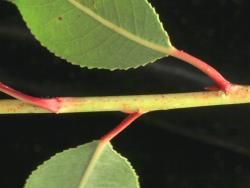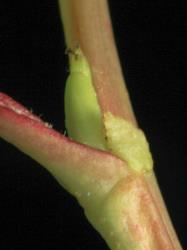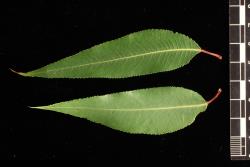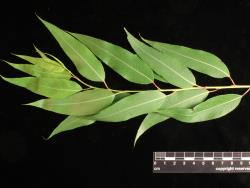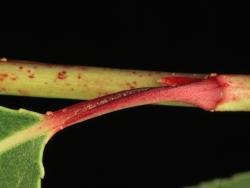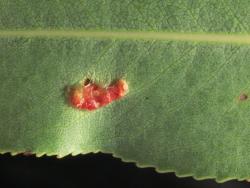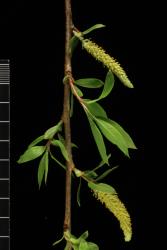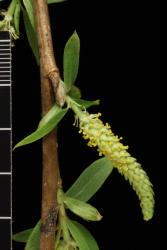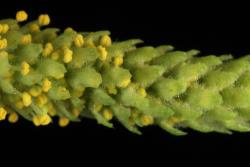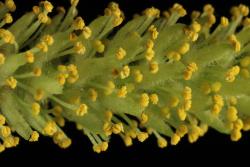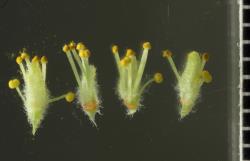Shrubs or small trees 2–3 m high. Current year's branchlets glabrous, yellow-green spotted with red, 1.5–2.1 mm diameter. Year-old branchlets light olive-brown (UCL94) to yellow-brown (UCL74), glabrous. Bud scale dark red-brown (UCL46) to dark pink (UCL6), glabrous. Stipule 2 mm long, narrowly ovate, not persisting. Petiole 7–15 mm long, glabrous, adaxial groove present, glands absent, base greyish red (UCL19). Emerging leaves green, with moderately dense tomentum, tomentum lost by the time leaves unfurl. Leaf lamina 89–108 mm long, 20–28 mm wide, length to width ratio 3.9–4.8:1, narrowly to very narrowly ovate, not falcate; base rounded; apex narrowly acute to acuminate; leaf galls absent or sparse; orange rust absent in late summer; margins flat, densely serrulate, teeth 1.8–2.0 mm apart; upper lamina surface smooth, slightly glossy, glabrous, stomata sparse to dense; lower lamina surface midvein raised, not glaucous to slightly glaucous, glabrous. Flowering branch 43–82 mm long. Catkins male, emergence coetaneous with leaves, 6 reduced leaves on flowering branch. Male catkin 33–64 mm long, 6–9 mm diameter; catkin rachis visible between flowers. Flower bracts 3.9 mm long, 0.8–1.2 mm wide, pale green, channelled, curved inwards on long axis; apex rounded, moderately densely villous all over. Male nectaries 2, wider than long, 0.4 mm long, 0.64 mm wide, pale yellow tinged pink. Stamens 4, filaments free, filament hairs present at base; anthers 0.50–0.60 mm long, yellow.
Salix gooddingii has 4 stamens per flower in New Zealand plants (4–6(8) in its natural range—Argus 2010). Male nectaries are variable in number and shape, at least 2 but there may be 3 outer nectaries and there may be extra tiny nectaries among the filaments. The male nectaries in the New Zealand plants turn red after the anthers open; this can easily be seen in old flowers. Male flower bracts are early-deciduous, so the bracts at the base of a catkin may be absent, making the pink nectaries more obvious. Male catkins are large (43–82 mm long including the stalk below the catkin). Anthers are yellow and small (0.5–0.6 mm long). Leaves are 89–108 mm long, 20–28 mm wide, ratio 3.9–4.8:1.
Similar to Salix nigra, the 2 being very similar in leaf size, leaf shape, and male catkins. The leaves of both are not glaucous below and are glabrous when mature. Male flowers of S. gooddingii have 4 stamens in New Zealand, while S. nigra has 6. Female plants will be S. nigra as only male plants of S. gooddingii are present in New Zealand.
In cultivation at Aokautere. It appears that the species has very little history of cultivation in New Zealand.
Not known in the wild in New Zealand.
Flowering: Early October.
Diploid, 2n = 38 (Argus 2010). Flow cytometry using two plants at Aokautere provisionally confirms diploidy.



